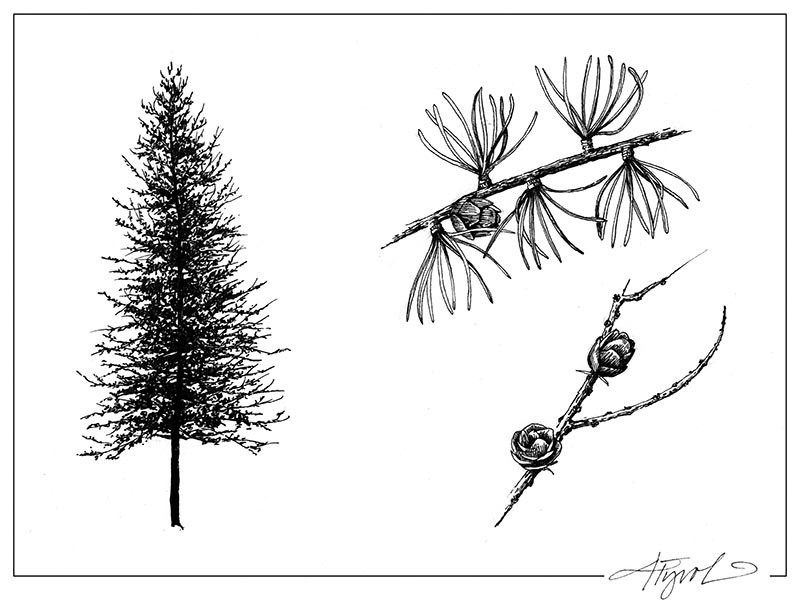
Tamarack is a tree with a number of aliases – hackmatack, eastern larch, or if you’re from northern Maine and feeling contrary, juniper. Whatever you call it, this scraggly tree, easy to overlook for most of the year, lights up the November forest. Weeks after leaf season has passed us by, the tamarack turns brilliant yellow and then orange, blazing like a torch amid the evergreens and fading, broad-leaf browns.
It’s an oddball tree, the only deciduous conifer native to our region, and I’ve often wondered how it manages to make a living. Deciduous trees are big spenders, investing in foliage that they use quickly and discard. This approach may seem wasteful, but in certain scenarios it’s a good strategy. Big leaves enable a tree to collect and bank a lot of carbon dioxide all summer; the tree then drops the leaves and takes the winter off.
For a needle tree in our climate, however, “deciduous” seems awfully close to “certain death.” Needles typically don’t photosynthesize as well as leaves do, but in an evergreen, they don’t have to. A spruce, for example, can spread out the work of growing new needles over several years, so its annual foliage costs are relatively low. And it has the advantage of a longer growing season; its needles, protected from the elements by waxy cuticles, can harvest carbon dioxide on short notice, whenever the temperature gets warm enough for photosynthesis. This low cost lifestyle has another important benefit, one that explains evergreen conifers’ predominance as you move north: they can grow, albeit slowly, in cold, meager soils, where nitrogen and other essential nutrients are scarce.
And then there’s tamarack. This past week, driving on a country road gilded with discarded needles, I was reminded of Aesop’s fable of the grasshopper and the ant. In a dendrological version of the story, I thought, the tamarack grasshopper would regret not a moment of his summer hedonism, continue to mock the ant, and settle down for a successful winter living on … absolutely nothing.
How does this tree feed itself? And how does it live not only in our region, where growth conditions are already plenty challenging, but all the way up to the edge of the Canadian tundra?
It turns out that there’s still a lot to learn about tamarack’s deciduous lifestyle. However, research on this and larch species in other parts of the world suggests that their success comes in part from special characteristics of their needles.
Those needles are deceiving. They may be wispy, but they’re efficient. Their relatively sparse placement along the branch stems means that a high percentage of them are well illuminated. As forest ecologist E.C. Pielou noted in The World of Northern Evergreens, “larch [needles] are small and widely spaced, so that on a given tree, they shade one another to a lesser degree than do those on both evergreen trees and broadleafs.” Even distribution of light ensures that most of the needles are fully engaged in photosynthesis.
Because deciduous needles don’t need waxy cuticles to protect them in winter, or for that matter, big doses of phenolic compounds to ward off winter herbivores, they don’t require as much carbon as evergreen needles. They use nitrogen more efficiently, and perhaps most impressive, they’re champion recyclers. Tamaracks and other larches are able to reabsorb a high proportion of nitrogen from their needles before these are shed – perhaps 20 percent more than other species of trees. This is a big savings on an essential nutrient for next year’s growth.
Tamaracks and their cousins are also remarkably well adapted to cold weather survival. Their lack of winter needles means that they’re less susceptible to leaching of nutrients by winter precipitation than other conifers, and they can withstand extreme cold temperatures through a process called supercooling. Essentially, a tree’s cells dehydrate, pushing water into spaces outside their walls, where crystallization won’t damage living tissue. This trick is shared with only a few of other trees in our region – spruce and paper birch are examples – and it gives tamarack an edge in the harshest growing conditions.
All considered, tamarack has more in common with Aesop’s ant than the grasshopper. Despite appearances, it’s thrifty, and earns its quiet winter. And for the next few weeks, it gets my vote for the fairest tree in the forest. Enjoy it while you can – a last bright flash in a fading season.

